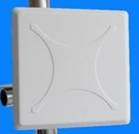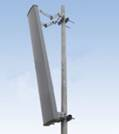RFID (Radio Frequency Identification) is a non-contact automatic identification technology. It can automatically identify the target object and obtain relevant data through radio frequency signals. The identification work does not need manual intervention. As a wireless version of barcode, RFID technology has the waterproof, antimagnetic, heat-resistant, long service life, large reading distance, data on the label can be encrypted and stored Larger, storage information changes freely and so on. RFID brings revolutionary changes to warehouse management:
1. Automatic access to the warehouse: the stable reading distance of the handheld reader can reach 2-5 meters, and the reading distance of the fixed reader can reach more than 12 meters. If using active electronic tags, the effective recognition distance can reach more than 30 meters . It effectively solves the problem that the barcode storage in the past must manually scan the barcode, realizes automatic entry and exit, and greatly improves the warehouse labor cost and forklift use efficiency.
2. Instant reading: As soon as the tag enters the magnetic field, the reader can immediately read the information in it; using RFID anti-collision technology and a fixed reader, it can instantly read dozens of hundreds of tags, greatly improving scanning efficiency and reducing Labor cost.
3. No obstruction to reading: When scanning traditional barcodes, the labels cannot be blocked. RFID can penetrate non-metallic and non-transparent materials such as paper, wood and plastic for transparent communication without the need for a light source. Provide a better scanning experience, can quickly tally, find goods, inventory.
4. Large data capacity: The largest RFID capacity is millions of Bytes. With the development of memory carriers, the data capacity also tends to expand. In the future, the amount of data that items need to carry will become larger and larger, and the demand for the expansion capacity of tags will increase accordingly.
5. Long service life, adapt to harsh environment: RFID’s radio communication method makes it applicable to high pollution and radioactive environments such as dust and oil pollution, with a life span of more than 10 years (100,000 reads and writes); traditional carrier labels for barcodes are easy Contaminated, but RFID is very resistant to substances such as water, oil and chemicals. In addition, because the bar code is attached to a plastic bag or outer packaging carton, it is particularly vulnerable to damage; RFID tags store data in the chip, so they can be protected from contamination, and RFID has strong anti-pollution ability and durability.
6. Reuse: The content of RFID tags can be changed. The direct benefit is that RFID tags can be reused. It can get rid of the situation that traditional barcode tags can only be used once, which can effectively reduce the cost of consumables for enterprises.
7. Security: RFID tags can not only be embedded or attached to products of different shapes and types, but also set password protection for the reading and writing of tag data, thus having higher security; because RFID carries electronic information, its data The content can be protected by a password, so that the content is not easy to be forged and changed, and the security is higher
8. Small size: RFID does not need to match the fixed size and printing quality of paper for reading accuracy. It is more suitable for the development of miniaturization and various forms to facilitate embedding or attachment to products of different shapes and types.
RFID tag
An RFID tag is physically composed of three parts: a tag, an antenna, and a reader.
Tag: It is composed of coupling elements and chips. Each tag has a unique electronic code. The high-capacity electronic tag has a user writing area and is attached to the object to identify the target object;

Reader : a device that reads RFID tag information, can be designed to be handheld or fixed;

Antenna: transfers radio frequency signals between tags and readers.



Principles of RFID technology
The basic working principle of RFID technology is that the reader sends a radio frequency signal of a specific frequency through the transmitting antenna. When the electronic tag enters the effective working area, an induced current is generated, thereby obtaining energy, and the electronic tag is activated, so that the electronic tag passes its encoded information through the built-in. The radio frequency antenna is sent out; the receiving antenna of the reader receives the modulated signal sent from the tag, and transmits it to the reader signal processing module through the antenna regulator. After demodulation and decoding, the effective information is sent to the background host system for related processing. ; The host system recognizes the identity of the tag according to the logic operation, makes corresponding processing and control according to different settings, and finally sends out instruction signals to control the reader to complete the corresponding read and write operations.

Compared with traditional barcode labels
| Traditional barcode label | RFID tag |
| The reading distance is within 0.5m | Long reading distance, UHF tag reading distance can reach more than 12m |
| Only one tag can be read at a time | Can read dozens or hundreds of tags at the same time |
| Can not penetrate the medium | Barrier-free reading, can penetrate paper, wood, etc. |
| Small data storage capacity | Large storage capacity |
| Easy to damage and easy to be polluted | Long service life, adapt to harsh environment |
| Not reusable | Reusable |
| Generally paper labels | Small size and various shapes. Available in plastic, ceramic and other packages |
Solution Overview
Adopt advanced RFID technology, paste electronic labels on the goods in the warehouse, give each goods a label, or mark the pallets to connect the goods with the pallets; then mount antennas and readers at the gates that enter and exit the warehouse, When the cargo pallet passes through the gate, the label will be read by the reader, so that the quantity of the incoming and outgoing goods can be known by calculating the number of the label, and then automatically enter and exit the warehouse through the warehousing software to complete the automatic entry and exit operation.
Paste the label on the shelf to identify the shelf, and at the same time add the reader and vehicle-mounted computer on the forklift, you can realize the association between the goods and the shelf; read the label of the shelf and the goods through the forklift reader, which can accurately record the goods The storage location of the forklift can also provide the location information of the forklift in the warehouse, so as to allocate the forklift.
The inventory process is completed using a handheld machine. The employee holds the handheld machine to read the data on the goods to be inventoried. After the inspection of the goods to be inventoried, at the same time, the relevant information of the goods can be known by reading the label. You can also enter the name of the goods. Find the location of the goods in the warehouse.
Solution architecture

Solution features
Bulk cargo identification
The use of a handheld RFID reader to bind RFID and goods on site saves the time of label printing and the time of manually matching labels to goods, greatly improving the efficiency of goods identification.
- After arrival, affix the prepared RFID tag to the goods;
- After all the goods are pasted with labels, the product number and specifications of the goods are selected in the handheld RFID reader;
- Use the handheld RFID reader to scan the goods with the label attached, the system automatically associates the RFID tags with the goods in batches, and the goods identification is completed
RFID cargo space
Use RFID tags to identify the cargo location. The RFID cargo location label number read by the wireless PC and reader on the forklift can ensure that the cargo is placed in the correct position. Generally, anti-metal RFID tags are used for the location tags.
Ultra high scanning speed
Barrier-free reading, can scan tens of hundreds of tags at the same time, a new scanning method, greatly improve storage efficiency and reduce storage costs.
Storage advantages
The storage capacity of the tag is large, and some tags can store several M data. Even ordinary RFID tags can store hundreds of K data, and the size of the tag is not affected by the amount of stored data. It can store enough cargo information in the tag.
Reuse
The service life of RFID tags is generally greater than 10 years (100,000 reads and writes), and the content can be changed, so RFID tags can be reused, RFID tags can be recycled, reducing the cost of enterprise storage.
Implementation benefits
Increase inventory availability by 5% to 10%
10% faster delivery
20% reduction in labor costs:
30% reduction in venue management fees
Increase the throughput of warehouse products by up to 20%
Reduce damage rate and write-off of expired goods up to 20%
The application of the RIFD intelligent warehouse management system ensures the speed and accuracy of data input in all aspects of cargo warehouse management, ensures that the enterprise can grasp the real data of the inventory in a timely and accurate manner, and reasonably maintain and control the enterprise inventory. Through scientific coding, it is also easy to manage the batch and shelf life of inventory goods. By using the system’s storage location management function, you can grasp the current location of all stocked goods in time, which is conducive to improving the efficiency of warehouse management.

